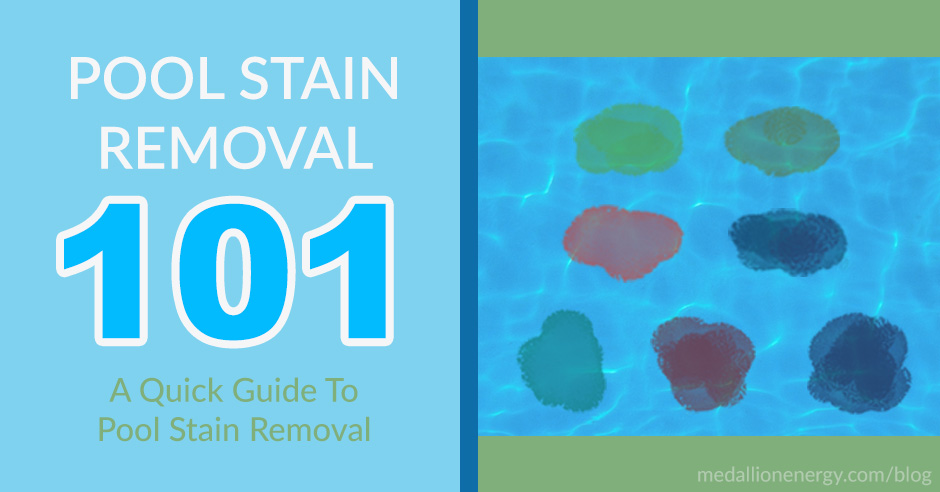Want to make pool stain removal easier?
The secret is all in the technique. Keep reading to learn how to remove organic, metal, rust, mineral, and other stains from your pool, the right way.
Just like ketchup splotches and oil droplets seem to find their way on to every white T-shirt you own, pool stains follow a similar path. At one point or another, no matter how careful you are, odds are you’re going to find one somewhere in your pool — maybe along the walls or spread across the shallow end stairs.
And if you’re reading this article, then you probably found a stain and want to remove it. If so, you’re on the right track.
Pool stains are common and appear for a number of reasons. So they aren’t necessarily a sign of bad maintenance. Everything from leaves and dirt, to minerals and bodily oils, can cause pool staining.
And when stains appear, they range in color, from bright green, red, and blue smears, to dark brown and red blobs.
But luckily, removing pool stains is simple when you know what you’re looking for. When you can identify a pool stain, removing it becomes much easier.
And that’s what this post is all about.
So if you’re ready to learn how to remove pool stains and prevent them from ever coming back again, keep reading. This post is for you.
Pool Stain Removal 101
A Quick Guide To Removing Pool Stains
How to identify pool stains
Pool stain removal starts with identifying the types of stains you’re dealing with. Most pool stains fall into 3 main categories:
- Organic pool stains
- Caused by everything from leaves, dirt, bugs, and berries, to algae, worms, and bodily oils
- Metal pool stains
- Copper, iron, and manganese can be introduced by pool equipment, corroded plumbing, or water sources
- Rust pool stains
- Caused by corroded pool fixtures and misplaced metal objects left in the pool
There are also waterline stains (pinkish goo) and mineral stains (chalk white scales). We’ll explain how to remove these later in the post as well.
The color of a stain indicates what type of stain it is. And by recognizing a few color combinations, you can diagnose your pool stains faster.
To identify the type of pool stain you’re dealing with, match it’s color(s) to one of the descriptions below:
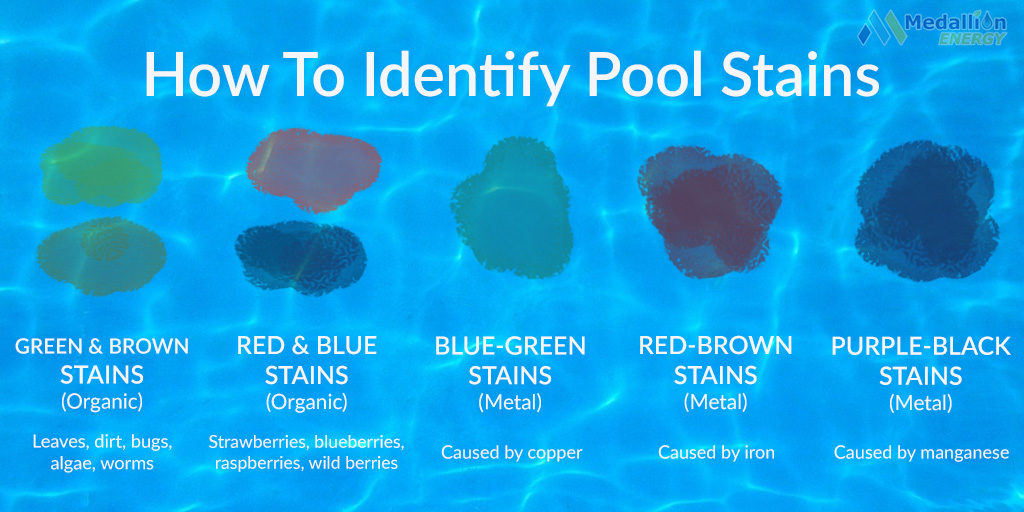


Green or green-brown pool stains (Organic)
Usually caused by decomposed leaves, twigs, algae, or other plant life. Sometimes caused by decomposed bugs or critters.
Red or blue stains (Organic)
Bright red or blue stains are usually the leftover remains of decomposed berries (strawberries, blueberries, raspberries, and wild berries from nearby bushes)
Blue-Green or Teal stains (Metal)
This distinct color combination is produced by copper.
Dark red or Brown stains (Metal)
Dark wine colored splotches are the result of iron.
Black or purple-ish stains (Metal)
This coloration is only produced by manganese
How to test for which type of pool stain you have
Can’t decide which stain you’re dealing with?
Do a little testing to find out.
Here’s how:
Testing the stain to see if it’s Organic
- Add a few sprinkles of granular chlorine directly to the stain
- Scrub the chlorine granules into the stain with a brush
- If the stain begins to fade away, it’s organic
- If the stain doesn’t fade away, it’s likely metal
Testing the stain to see if it’s Metal
- Add about a handful of ascorbic acid (or crushed Vitamin C) directly to the stain
- Scrub the ascorbic acid into the stain
- If the stain begins to fade away, it’s metal
(This may also work on rust stains too)
Testing the stain to see if it’s Rust
- Add about a handful of dry acid (sodium bisulfate) directly to the stain
- Brush the dry acid into the stain
- If the stain begins to fade away, it’s rust
Once you’ve identified your pool stain, it’s time to start the removal process. Don’t worry, it’s much faster and way simpler than you think. It’s all about the technique.
How to remove pool stains
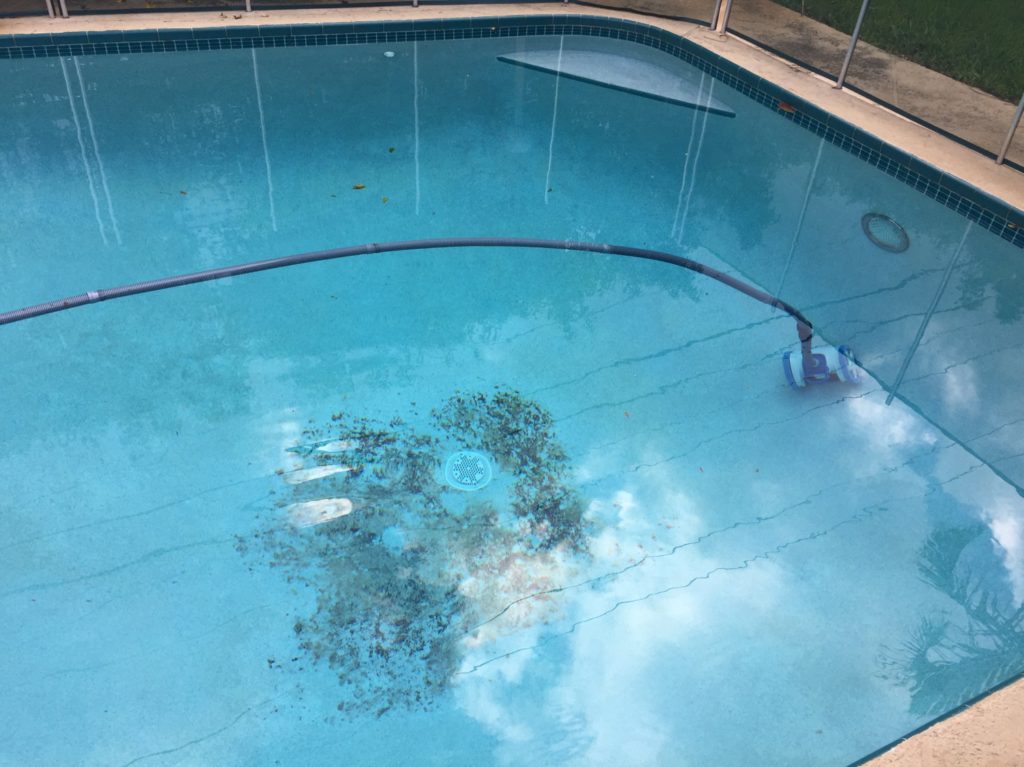


Removing organic pool stains
Good news: Of all pool stains, organic pool stains are the easiest to remove
That said, you’ll still need to use a little elbow grease to get rid of them. Luckily, whether you’re trying to remove leaf stains or algae stains from your pool, there’s a simple method to follow.
You can remove most organic pool stains by:
- Shocking your pool
- Applying granular chlorine to the stain
- Allowing the chemicals to absorb
- Scrubbing the stained area
Simple enough, yes, but it can be improved.
For the most effective organic pool stain removal, follow these steps:
- Test and balance your pool’s pH and alkalinity levels
- Proper pH is between 7.4-7.6, and alkalinity between 100-150
- Balancing these chemicals will make the soon-to-be-added chlorine way more effective
- Use at least 2 pounds of calcium hypochlorite pool shock to super shock your water
- 1 bag per 5-gallon bucket of water. Gradually mix the shock into the water bucket.
- Shock at dusk or night to avoid chemical depletion from the sun
- Wait a few hours for the shock to circulate
- Apply 1-2 cups of granular chlorine to the stain
- Scrub the granular chlorine into the stain
- If the brush doesn’t work, try using a soft tile grout scrubber
- Continue scrubbing and applying granular chlorine until the stain is gone
For especially tough organic stains use an enzyme treatment. They can be purchased at any pool store, and help break down organic matter that’s too tough for just chlorine.
Related: 11 Household Products For Cleaning a Pool
Removing metal pool stains
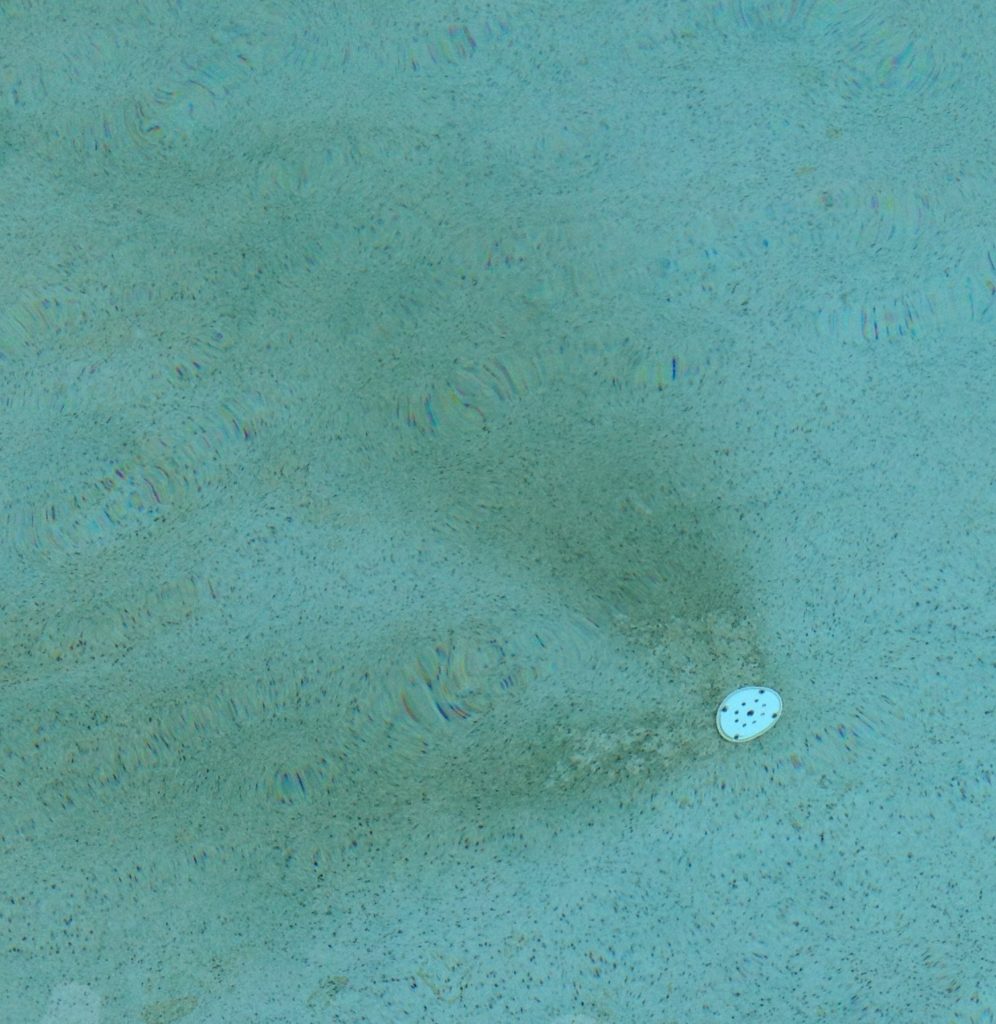


Metal pools stains are a bit trickier. They only respond to certain chemicals, so chemicals like chlorine don’t make a dent.
But there are chemicals that do.
- Removing iron pool stains
- Ascorbic acid is found in most stain and scale products and works great for removing iron-based stains.
- Removing copper pool stains
- Citric acid works similar to ascorbic acid but is more effective at treating copper based stains.
If you aren’t sure what type of metal you’re dealing with, you can bring a water sample to your local pool store for testing, or purchase a pool metal test kit.
For the most effective metal pool stain removal, follow these steps:
- Deactivate excess metals with a metal reducer (like Metal Free or Metal Klear)
- Add a 1/2 pound of ascorbic acid per 10,000 gallons or water
- For tough stains, sprinkle ascorbic or citric acid directly onto the spot
- Scrub the stains
- Run your filter for at least 1 hour
- Repeat steps 2-4 until stain gone
- To finish, add a metal eliminator pack to your skimmer basket to prevent future buildup
Removing rust pool stains
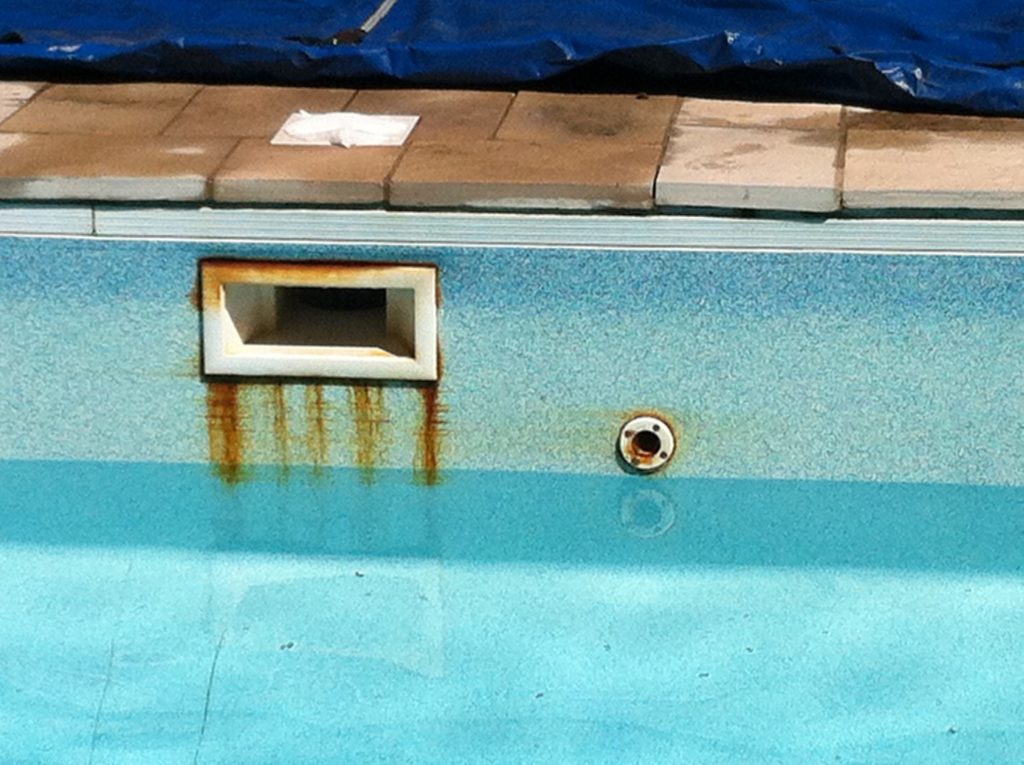


Rust isn’t as bad to deal with as the other stains. And sometimes, it can even be treated with some of the same methods used for organic and metal stains.
But if you want to remove a rust pool stain fast, follow these steps:
- Fill up a sock with around a 1/2 cup of dry acid
- Place the dry acid filled sock over the stain
- Use a pole or weight to keep the sock pressed against the rust
- Check the sock every 1-2 minutes
- If the stain is still there, continue “soaking” it with the sock
- Scrubbing the stain with ascorbic or citric acid can speed up the process
- Remove the sock as soon as the stain is gone to avoid a discolored spot
This also works if you’re trying to get rust stains off the bottom of the pool. Simply use a telescopic pole to apply the dry acid sock to the stain.
Removing waterline pool stains
If you look at your pool’s water line and see a white-pinkish colored residue, this section is for you.
Most water line stains are naturally caused over time by a buildup of organic matter like dirt and bodily oils.
To remove pool waterline stains:
- Add an enzyme treatment to your pool
- Brush the waterline stains with sprinkles of granular chlorine
- Use a brush or pool stain eraser for hard stains
Removing mineral pool stains
Similar to waterline stains, mineral stains are the scaly chalk white deposits that tend to form right above your water line. They’re usually caused by excess calcium in the water.
There are few ways to remove mineral stains, which include:
- Mixing a 50/50 vinegar-water solution and using it to scrub out the stain
- Backing soda and vinegar mixture plus scrubbing
- Lime juice and salt plus scrubbing
Related: How To Remove Calcium Scaling
How to prevent swimming pool stains
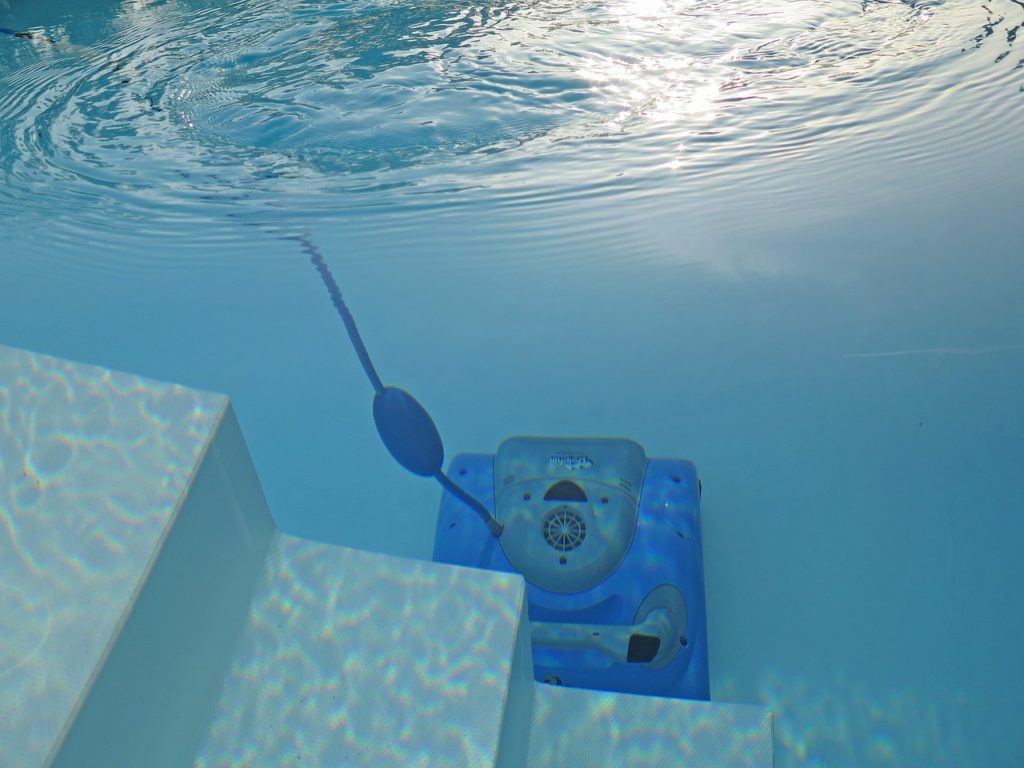


So what’s the one surefire way to prevent pool stain?
Bulletproof pool maintenance habits.
What do we mean by that?
Well, we don’t expect you to brush your pool 24/7 or anything crazy like that. Instead, just a few changes that’ll keep your pool clean and fend off buildup. A defense again future pool stains.
To prevent pool stains from returning in the future:
- Test and balance your water at least twice a week
- Keep your pool properly sanitized (3 ppm)
- Skim and brush the pool 2-3 times each week
- Vacuum at the end of each week for a spotless and debris free floor
- Add a mineral sequestering agent to lock up excess minerals
- Add a metal eliminator pack to contain and deactivate excess metals
Related: How To Balance Your Swimming Pool Water in 7 Easy Steps
Closing thoughts on pool stain removal
Getting rid of pool stains is simple when you know which tools to use for the job. And when you start by identifying what kind of stain you’re dealing with, removing it becomes much easier. Follow the steps that were outlined in this post, and you’ll have spot free pool in no time.
If you liked this post, you might also like:
- Fix a Green Pool in 5 Easy Steps
- 7 Cheap Ways To Heat a Swimming Pool
- 7 Ways To Lower Chlorine in a Pool

